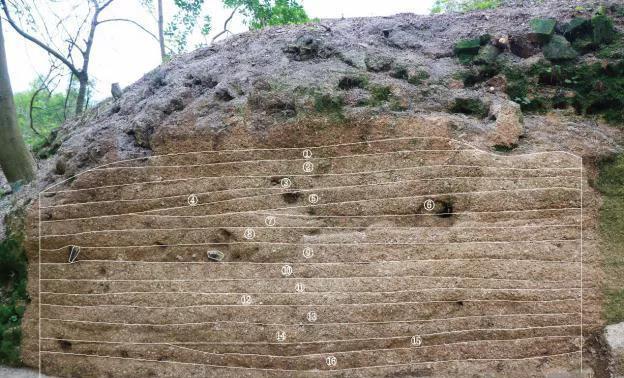This reporter learned yesterday from the Guangdong Provincial Institute of Cultural Relics and Archaeology that the investigation and study of the base site of the Acropolis in Guanghai, Jiangmen, is currently in full swing. In order to do a good job in the investigation and research of the newly discovered Guanghai Acropolis city-based site, the Guangdong Provincial Institute of Cultural Relics and Archaeology was entrusted by the Jiangmen Museum to investigate and explore the archaeological survey of cultural relics. Researchers unearthed relics such as blue glaze and sauce glazed porcelain pieces from the middle and late Ming Dynasty in the rammed soil layer.

The project is divided into two phases: one and two phases. The first phase has carried out archaeological surveys and explorations of the remains of the Fengshan section and the Qilin Mountain section in the northern city wall site of Guanghai Town. Among them, the remains of the fengshan section of the city wall belong to a section of the northern city wall of guanghai acropolis, running east-west; the remains of the qilin mountain section of the city wall are located in the northwest corner of the north wall site of the Guanghai Acropolis, southwest-northeast. Both sections of the city wall are built according to the undulating terrain of the mountain where they are located, and the wall is built with three rammed earth panels, and its rammed earth construction method, rammed earth material and structure, and the characteristics of the inner stack of stones are the same as those of the east city wall. Among them, the three-phase rammed earth accumulation shown in the section of the city wall of the Fengshan section can correspond to the several major urban construction changes of the Guanghai Acropolis in the Ming Dynasty recorded in the "Xinning County Chronicle" and "Guangdong Tongzhi". The surface of the city wall collects gray bricks commonly found in the Ming Dynasty, and relics such as blue glaze and sauce glazed porcelain pieces of the middle and late Ming Dynasty have been excavated from the rammed earth layer. In summary, the ruins of the city wall of the Fengshan section and the Qilin Mountain section should be built no later than the Ming Dynasty, which has a relatively important cultural relics value and provides an important basis for in-depth understanding of the creation and development of the Guanghai Acropolis.
The second phase entered the market at the end of August and is currently in the initial stages of the investigation, and the following work is planned. To improve the unsolved problems in the first phase of exploration, deepen the understanding of the construction of the city wall and its auxiliary military facilities; conduct a meticulous survey inside the Acropolis, and look for architectural remains such as offices, barracks, arsenals, and temples according to the ancient maps on the county records; investigate and explore the remains of the city gate and the urn city and the moat outside the city wall.
Text/Guangzhou Daily, Xinhuacheng Reporter: Xiao Huanhuan Correspondent: Zhu Ke
Photo / Guangzhou Daily, New Flower City Reporter: Xiao Huanhuan Correspondent: Zhu Ke
Video/Guangzhou Daily Xinhuacheng Reporter: Xiao Huanhuan Correspondent: Zhu Ke
Guangzhou Daily New Flower City Editor: Cai Lingyue